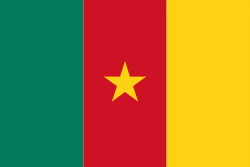Yaoundé Nsimalen International Airport (Yaounde)
Yaounde Nsimalen International Airport (Aéroport international de Yaoundé-Nsimalen), also known as Nsimalen airport, is the second busiest and largest public airport in Cameroon. The airport is located 27 km (16 miles) south of the capital Yaounde, near Nsimalen in Cameroon's Centre Province.
Starting operations in 1991, Nsimalen was built to supersede the old international airport in Yaounde that was getting absorbed by the rapid growth of the city, it was also too close to the oil deposits of SCDP ("Société Camerounaise de Dépôts Pétroliers" or Cameroon Oil Storage Company). This former international airport of Yaounde now serves as an airbase for the air force of Cameroon.
In 2004, the Nsimalen airport served 190,487 passengers. Yaounde Nsimalen International Airport has 14 direct flights to 11 countries. It is also the focus city for the most popular airline in Cameroon, Camair-Co, successor to the defunct Cameroon Airlines. The airport's growth of international traffic is 4% per year. The government has set a goal of servicing 1.5 million passengers and 50,000 tons of cargo per year.
Starting operations in 1991, Nsimalen was built to supersede the old international airport in Yaounde that was getting absorbed by the rapid growth of the city, it was also too close to the oil deposits of SCDP ("Société Camerounaise de Dépôts Pétroliers" or Cameroon Oil Storage Company). This former international airport of Yaounde now serves as an airbase for the air force of Cameroon.
In 2004, the Nsimalen airport served 190,487 passengers. Yaounde Nsimalen International Airport has 14 direct flights to 11 countries. It is also the focus city for the most popular airline in Cameroon, Camair-Co, successor to the defunct Cameroon Airlines. The airport's growth of international traffic is 4% per year. The government has set a goal of servicing 1.5 million passengers and 50,000 tons of cargo per year.
| IATA Code | NSI | ICAO Code | FKYS | FAA Code | |
|---|---|---|---|---|---|
| Telephone | Fax | ||||
| Home page |
Map - Yaoundé Nsimalen International Airport (Yaounde)
Map
Country - Cameroon
 |
 |
| Flag of Cameroon | |
Early inhabitants of the territory included the Sao civilisation around Lake Chad, and the Baka hunter-gatherers in the southeastern rainforest. Portuguese explorers reached the coast in the 15th century and named the area Rio dos Camarões (Shrimp River), which became Cameroon in English. Fulani soldiers founded the Adamawa Emirate in the north in the 19th century, and various ethnic groups of the west and northwest established powerful chiefdoms and fondoms. Cameroon became a German colony in 1884 known as Kamerun. After World War I, it was divided between France and the United Kingdom as League of Nations mandates. The Union des Populations du Cameroun (UPC) political party advocated independence, but was outlawed by France in the 1950s, leading to the national liberation insurgency fought between French and UPC militant forces until early 1971. In 1960, the French-administered part of Cameroon became independent, as the Republic of Cameroun, under President Ahmadou Ahidjo. The southern part of British Cameroons federated with it in 1961 to form the Federal Republic of Cameroon. The federation was abandoned in 1972. The country was renamed the United Republic of Cameroon in 1972 and back to the Republic of Cameroon in 1984 by a presidential decree by president Paul Biya. Paul Biya, the incumbent president, has led the country since 1982 following Ahidjo's resignation; he previously held office as prime minister from 1975 on. Cameroon is governed as a Unitary Presidential Republic.
Currency / Language
| ISO | Currency | Symbol | Significant figures |
|---|---|---|---|
| XAF | Central African CFA franc | Fr | 0 |
| ISO | Language |
|---|---|
| EN | English language |
| FR | French language |















